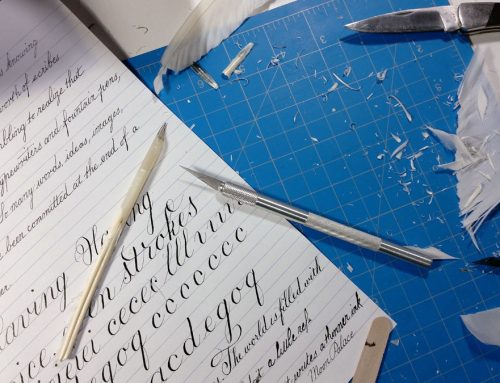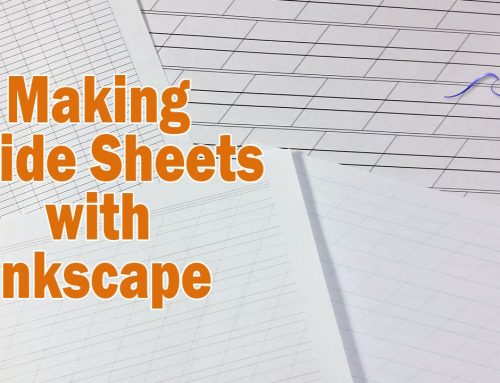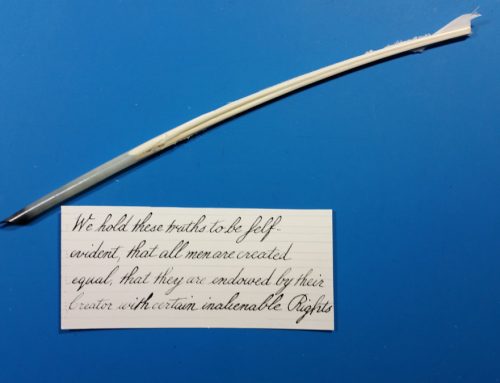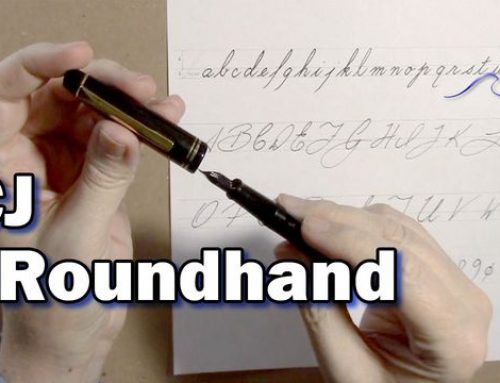Whether you are a calligrapher, a comic artist, or just a fan of parallel lines, a liner guide is a valuable tool that can make your life a lot easier…if you understand it. Perhaps the most popular guide is the
Here’s the tool we are talking about:
 This probably looks familiar as that weird tool that you couldn’t fathom how it worked. Basically, you rotate the wheel in the middle until you get the distance between the lines you want, and then you run this back and forth along a T-square or a ruler with a pencil in one of the guide holes. You then put the pencil in a different guide hole and slide the guide back, and so forth until you have the line pattern you want.
This probably looks familiar as that weird tool that you couldn’t fathom how it worked. Basically, you rotate the wheel in the middle until you get the distance between the lines you want, and then you run this back and forth along a T-square or a ruler with a pencil in one of the guide holes. You then put the pencil in a different guide hole and slide the guide back, and so forth until you have the line pattern you want.
The Scales
You can see quite a few number on the liner guide. They are grouped like this:
 The RED area is the metric/mm scale, the YELLOW area is the fractional inch scale, the BLUE and LT.BLUE area is the conversion scales.
The RED area is the metric/mm scale, the YELLOW area is the fractional inch scale, the BLUE and LT.BLUE area is the conversion scales.
Both scales are normalized to that long middle row of pencil guides in the middle of the wheel. When they are vertical as shown above, they are 3.18 mm or 1/8 inch apart. You can decrease the distance between the guides by turning the wheel so either the millimeter size you want is lined up with the “mm” index mark on the upper left side of the guide, or the fractional-inch size you want is lined up with the “in” index mark on upper right side of the guide. This distance will be the final distance between one of the middle guide holes and another right next to it.
If you want sizes larger than 1/8″, that’s when you have to start doing a little bit of math and start skipping holes. For example. Let’s say you wanted to have a distance between lines of 1/4″. You put the “in” scale at 1/8″ and you only use every-other hole when you draw lines. You draw a line, you then skip the next hole, and then use the next hole after that to draw the second line. And so on.
If you wanted the distance between the lines to be 21/64″, you’d do pretty much the same thing. You’d rotate the wheel so that the mark after 3/32″ (this unlabeled mark would be 7/64″) is lined up with the “in” index. You draw your first line. Then you skip down 3 holes (not to the 3rd hole but three holes down from the first hole; i.e. the 4th hole) and draw the next line — and repeat as desired. Your lines will now be the right distance apart because 3 * 7/64″ = 21/64″.
The maximum line distance you can draw from the center guide holes is 1-7/8″ (47.635 mm).
The metric side is done just the same. Let’s say you want your lines to be 5.4 mm apart. Since the scale doesn’t go that high, you know that you’ll have to skip one or more guide holes. We find that if the scale is set to 2.7 mm and every-other guide hole is skipped, the final line distance will be 5.4mm.
The Hole Groups
 There are two hole groups, one on either side of the central row. These represent common line ratios for writing upper- and lower-case letters. The left one (in the red box) is marked 3/5 and the right one (in the yellow box) is marked 2/3. The first number is the “x” height, or the standard line height for lower-case letters. The second number indicates the height of a capital letter (the x-height plus the ascender height).
There are two hole groups, one on either side of the central row. These represent common line ratios for writing upper- and lower-case letters. The left one (in the red box) is marked 3/5 and the right one (in the yellow box) is marked 2/3. The first number is the “x” height, or the standard line height for lower-case letters. The second number indicates the height of a capital letter (the x-height plus the ascender height).
The 3/5 scale on the left side has three options. The single line of holes on the far left indicate the ascender height, the x-height, and the descender height. In this line, the ascender and descender heights equals the scale height; the x-height equals 1.5 the scale height.
The next line of holes is the same as the one on the far left but scaled up 2x (the x-height is 3x the scale height, the ascender and descender are each 2x the scale height). The innermost line of holes are three groups of ascender & x-height separated by a line space equal to the size of a descender.
Except for the difference in upper-/lower-case ratios and that they are arranged differently, the guides on the 2/3 right side work just the same as the ones on the left. EXCEPT — the distance between the guide holes is 5/6ths what you’ve set on your scale (if your scale is set at 3 mm, the line distance will actually be 2.5 mm). It seems to be related to metric conversion, but it’s hard for me to see how this is usefully implemented. In any case, if you use these guides, don’t forget to do the necessary math.
The Conversion Scale
The reason for this scale is dubious, confusing to a lot of people, and could really be easier to use (e.g. having mirrored 10-step scales). When you set your guide, you’ll note that the line of holes will either slope down from left to right (when using the “mm” scale) or slope up (when using the “in” scale). If you want to change scales, you need to use the conversion numbers on the bottom.
 If you set the “mm” scale to 2, you note that the mm side of the conversion scale reads 5. Now comes the part that trips people up: you need to multiply this reading (5) by 10/8 — which is the ratio between the two conversion scales — to end up with 6.25. If you then turn the wheel so that the “in” side of the conversion scale is at 6.25, you’ll notice that the angle of the lines of holes is the same as before, just flipped. The “in” scale is at about 5/64″. To check our settings, we note that 2.0mm equals about 0.07874″; if we express 5/64 in decimal, we get 0.078125 — pretty close.
If you set the “mm” scale to 2, you note that the mm side of the conversion scale reads 5. Now comes the part that trips people up: you need to multiply this reading (5) by 10/8 — which is the ratio between the two conversion scales — to end up with 6.25. If you then turn the wheel so that the “in” side of the conversion scale is at 6.25, you’ll notice that the angle of the lines of holes is the same as before, just flipped. The “in” scale is at about 5/64″. To check our settings, we note that 2.0mm equals about 0.07874″; if we express 5/64 in decimal, we get 0.078125 — pretty close.
Obviously it also works the other way around, except you need to multiply by 8/10 instead.
The Rest
There are several other aspects of the guide that merit mention.
First, there are the triangles. As best I can figure, they are most useful to help keep the guide aligned when you are using a handheld ruler as your straight-edge base instead of a T-square. You draw a vertical line and you can then align the vertices of the leftmost triangles to help maintain some degree of parallelism.
The left side has a 75° slant line which is obvious how to use. The right side has a 68° degree angle that isn’t nearly as obvious how it’s used. You can’t flip over the guide because it won’t slide easily. Instead, you need to flip the guide onto the 68° side.
 Now you can easily draw slant lines for some styles of lettering.
Now you can easily draw slant lines for some styles of lettering.
The saw lines and the tilde are mysteries to me. The check mark might also be used for alignment, and the long leg can be used for drawing 60% slant lines.
And that’s about it on what I’ve managed to figure out about the Linex Liner Guide. Since I generally use metric measures when I do calligraphy, I find this guide a bit more useful than the Ames. I also like that it being green (most Ames guides are clear) means it doesn’t disappear on my desk.
NOTE: You might find some of the holes in a new-from-the-package guide might not be as open as you’d like; i.e. your pencil point won’t go through. Just take a straight pin that can easily clear one of the more open holes, insert it into a small hole, and wiggle it around a bit in a circular fashion. Easy-peasy.
And here is a video I found online that shows you the guide in action:
http://youtu.be/MnWqU5ioUY4





